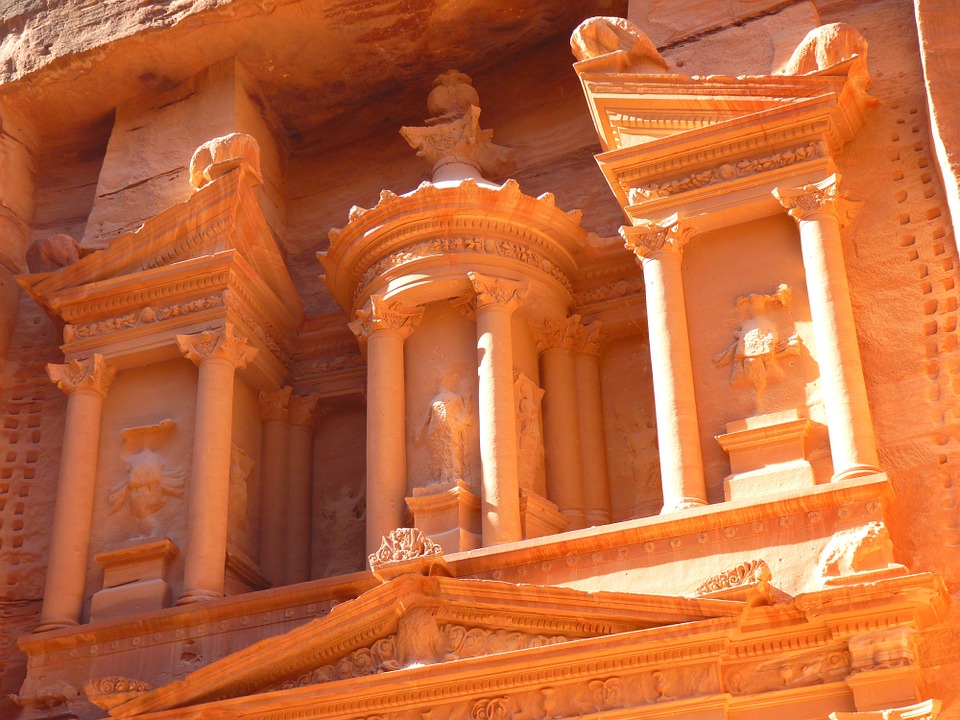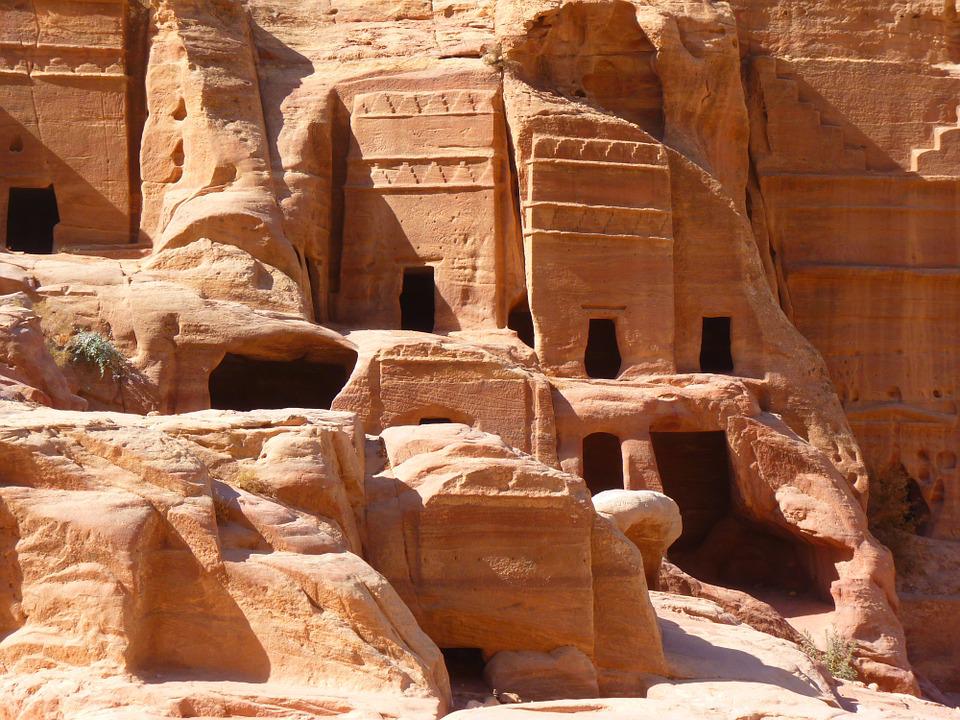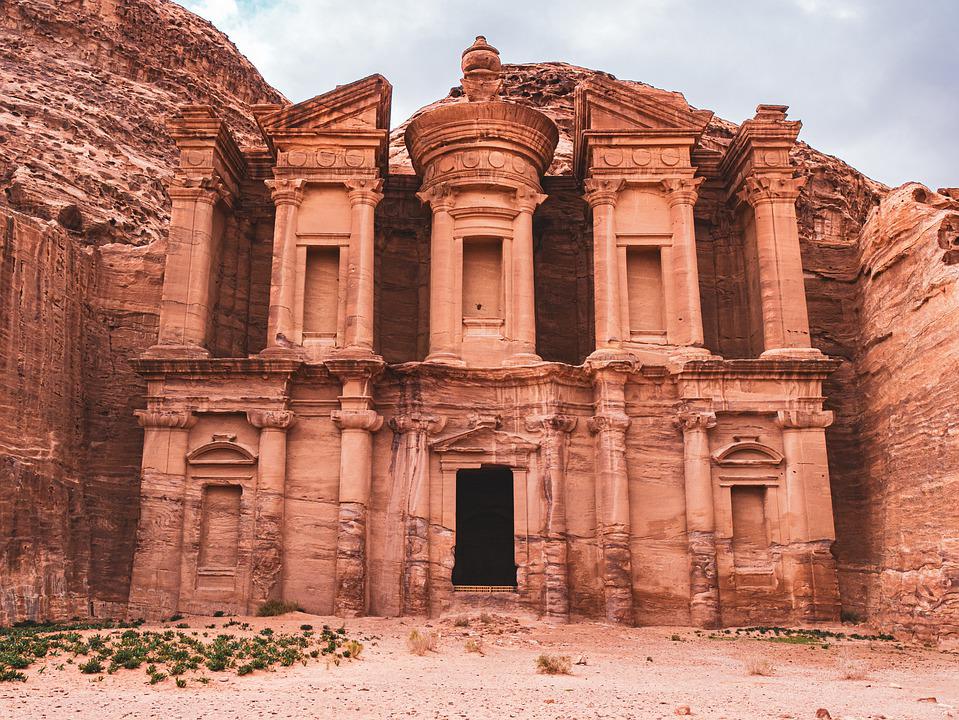The Ancient City of Petra

The Treasury in the Ancient City of Petra
The ancient City of Petra is an area that rests amid the rugged – yet vibrantly colored – canyons and mountains within the desert. It is carved and carefully sculpted within the cliff faces composed of sandstone and made up of a multitude of dynamic reds, oranges, pinks, and whites. For several centuries, this area was identified as the “Lost City of Petra”.
While now found, it has been estimated that only 15% has been officially uncovered. The remaining 85% - according to Al-Muheisen, an individual that has been excavating the region since the late 1970s – is still located under the ground and has yet to be touched.
Where is the Petra Located?
The rock city of Petra is located within the southwestern region of Jordan in the area identified as the Hashemite Kingdom. This area is in-between that of the Dead Sea and that of the Red Sea. It is directly adjacent to the Jabal Al-Madbah mountain.
It includes components that are half-carved and those that are half-built directly into the desert cliffs just to the southwest of the City of Amman, Jordan. The mountains that surround the ancient world architecture known as Petra includes several gorges and numerous passageways.
What are Other Names is Petra Known By?
The ancient City of Petra, Jordan is known by a couple of different names. These include:
· The Rock City
· The Lost City of Petra
· The Red Rose City
· The Rose City
· Raqemo
· Raqmu
What Does the Name “Petra” Mean?
“Petra” is a word that gained its origination from the Greek-based word “petros”, which means “rocks”. In some instances, the translation converts to “stone, rock”. It is believed that this name stemmed from Greek visitors. It was given due to the fact that the carved sandstone was highly distinctive and truly characterized the area.
When was the Petra Built?
According to research, it is believed that the ancient City of Petra was built in the 3rd Century, B.C. Studies indicate that the area surrounding the rock city since the year 7000 B.C.
Who Built Ancient Petra?
The Nabataeans built the ancient City of Petra. This was an Arabic group of individuals who were known to be master builders. Their skills were highly advanced at the time. The group specialized in refining copper, hydraulic engineering, and the production of iron.
At its time of construction, these inhabitants referred to the area as Raqmu or as Raqemo. Immediately after construction and settlement, ancient Petra became the capital city of the Nabataeans.
What is the Ancient World Importance of Petra?
In terms of the ancient world, Petra was the capital of the Kingdom of the Nabataeans. Additionally, it served as the main center of their caravan-based trade. It served as a control for the main routes of commercial trading that passed through into Gaza, Damascus, Bosra, Aqaba, Leuce Come, and across the vast desert all the way into the Persian Gulf.
Why is Petra, Jordan Often Called the Lost City?
The ancient City of Petra is believed to have been constructed in the 3rd Century, B.C. In the year of 1812, a Swiss explorer by the name of Johann Ludwig Burckhardt discovered the ruins of Petra. The explorer was on a mission to improve his Arabic in Syria. On his travels, he heard of a story surrounding a German-based explorer who had been killed in search of the ancient city.
It was then he developed a solid determination to find the city, himself. He felt inclined to hide his identity, so he started using the name Sheikh Ibrahim Ibn Abdallah. He made a point to blend in with the locals within the area of Aleppo. Once being in the area for a few years, he started the journey to uncover the lost City of Petra.
On his way to the City of Aqaba, he heard talk of the nearby ruins. He informed the local guide that he was working with that he had a desire to sacrifice a goat and he wanted to go to the tombs. The guide led him directly through the Siq. It was at this point he saw Petra, Jordan for himself.
He wrote about his discovery and immediately thereafter, several explorers from the West made the trip to study the ancient architecture and make notes and drawings. Since then, it has immediately taken off in popularity.
What is the Monastery at Petra?
The Monastery (Ad Deir) at Petra is a highly monumental building that has been constructed through the process of carving out rock. It is located at the northwest of the center of Petra. It received its name – “Ad Deir” – by natives during the Byzantine times during Christian use because of the inscription of crosses on the back wall of the interior.
Is Petra in the Bible?
“Petra” is not specifically mentioned in the Bible; however, the name “Sela” is mentioned. “Sela” means “rock” in the Hebrew language. “Sela” translates from Hebrew to “Petra” in the Greek language. Historians believe that the “Sela” outlined in the Bible is actually the “Petra” that we know of today.
It is specifically outlined in 2 Kings 14:7. Most historians agree that it is referenced in Judges 1:36, 1 Samuel 23:28, Isaiah 16:1, and Isaiah 42:11. Its general location indicates that it was located near the Valley of Moses.
What is the Religious Significance of Ancient Petra?
According to the history of the Arabs, the ancient City of Petra is believed to be the location where Moses took his staff, struck a rock, and water immediately flowed. It is believed that the brother of Moses’ brother named Harun (Aaron) is buried.
This burial location is at Mount Hor. Today, this is identified as Mount Aaron (Jabal Haroun). The “Wadi of Moses” was the name given by the Arabs to the valley that is situated at the head of the site of ancient Petra.
Is Petra One of the New 7 Wonders of the World?
Yes, the ancient City of Petra was made one of the 7 New Wonders of the World in the year of 2007. A total of 100 million people voted on it to be included. The area includes living dwellings, tombs, and temples that were carefully crafted through chiseling into the sandstone.

The Nabataean Tombs in the Lost City of Petra
What Was Petra Like When It Was Occupied?
When Petra was occupied by the Arab Tribe – the Nabataeans – it was a capital city that was known for being a trade center. Spices were the main commodity. The tribe built a highly productive water system that allowed for vast farming and lush gardens. At its most populated, it is believed approximately 30,000 resided within the City of Petra.
What Caused Ancient Petra to Become Abandoned?
The Nabataeans gained a vast amount of riches due to being a trade route between Arabia and Syria. Addition to regional trading, they made trades with individuals from Egypt and the Mediterranean. They accumulated great riches.
This resulted in their being a target. After being attacked numerous times, they fell to the Romans. Just four decades later, the city was incorporated into Arabia, which was a Roman province.
While the people in the city continued to thrive, the shift of the trade routes detrimentally impacted their overall success. Additionally, a couple of earthquakes absolutely devastated the area. By the time of the 13th Century, A.D, Petra, Jordan had been completely abandoned and was quickly forgotten.
What is in Ancient Petra?
The ancient City of Petra includes many houses, tombs, and temples. There are also monuments, a monastery, the Treasury, and a very large theater. All of these buildings were carved within the sandstone and reflect the traditions of the time and the Greek style. There are dams and a highly advanced water irrigation system.
How Can You Access the Ancient City of Petra?
The ancient City of Petra is only accessible by foot or by horseback, donkey, or camel. Individuals must travel through a Siq (crevice), which is long, narrow, and winding. The gorge is steep and spans over a length of nearly one mile.
Throughout the gorge that is traveled, there are large carvings that may be observed. It eventually opens up into a sandstone split that is approximately 10 feet in width, which makes for a highly dramatic entrance into the awe-inspiring city.
Why Was Petra’s Location a Secret After it Was Abandoned?
It has been established that the Bedouins knew where the ancient City of Petra was at all times. They kept it to themselves because they believed that riches were within the tombs. Being that only 15% of the area has been discovered, it is possible that numerous riches still abound at Petra; however, this is – ultimately – a mystery.
Can You Go Inside of Petra?
Yes, you may go inside of the City of Petra and most of the structures located at the site. These include the Obelisk Tomb, the Theater, Urn Tomb, Palace Tomb, Royal Tombs, Colonnaded Street, the Great Temple, the Byzantine Church, Qasr al-Bint, and the Monastery. Visitors to Petra, Jordan are not permitted to enter the Treasury; however, it may be viewed in all of its magnificence from outdoors.
What Happened to the Nabataeans?
In 363 A.D, the City of Petra experienced a highly devastating earthquake that destroyed numerous buildings and its system that supplied water to the region. The Nabataeans slowly started to make their way into other regions. Eventually, they started learning Greek and completely transformed to Christianity.
Arab-based invaders eventually discovered that the people had turned into peasants. The lands that they possessed were divided between the Kingdom of Kinda, Byzantines, Himyarites, and Ghassanids. Petra was left abandoned.
Are the Nabataeans Mentioned in the Bible?
No, the Nabataeans are not mentioned in the Bible. According to historians, there are references regarding them in the Bible. It is believed that they are direct descendants of Ishmael. This is the oldest son of Abraham that he had with the handmaid of his wife Sarah, Hagar.
As a result, it has been established that the Nabataeans were considered to be Canaanites – which are mentioned in the Bible. Josephus outlines their existence when he states, “These inhabited all the country from the Euphrates to the Red Sea and called it Nabatene.”
When is the Best Time to Visit Petra, Jordan?
If you want to visit Petra, Jordan, you should do so during the Months of March, April, May, September, October, and November. In doing so, you will avoid extremely hot and cold temperatures. When there, you should go at the opening of the gates – which is 6am – or in the evening. Again, this helps to avoid severe weather conditions; however, it also allows you to explore the site without battling large crowds.
Do You Need a Tour Guide When Visiting the Ancient City
of Petra?
A tour guide is not required when visiting Petra, Jordan, but it is highly recommended. These professionals will share the rich history of the site. Also, they will provide answers to questions, aid in preparing you for various experiences, and advise you on what is and what is not permitted.
What is Petra by Night?
Petra by Night is a special light show that occurs after dark. It happens on Mondays, Wednesdays, and Thursdays from the time of 8:30pm to 10:30pm. You will be guided by candlelight through the Siq. Once at the Treasury, you will be seated and offered Bedouin tea. Melodies are presented on the flute and the rababa. The unique story of Petra, Jordan is also shared.
Conclusion
The ancient City of Petra is truly a unique marvel for all who have an appreciation for history and architecture. It is a city that was carefully crafted into the canyons and mountains deep inside of the desert. Once a thriving center for trade and the capital of the Nabataean Empire, the area was abandoned and sat completely empty for many, many centuries.
Today, it is a thriving tourist location; however, there is still much to be discovered. Until then, it continues to captivate the mind and keep its mysteries hidden. The ancient City of Petra remains to be one of the greatest of all unsolved mysteries, worldwide.

The Monastery in Petra, Jordan
Return to Ancient City of Petra - Top of Page
Return to Greatest Unsolved Mysteries Home Page
Explore the Index of Greatest Unsolved Mysteries
Copyright © 2009-2023 Greatest-Unsolved-Mysteries.com. All Rights Reserved